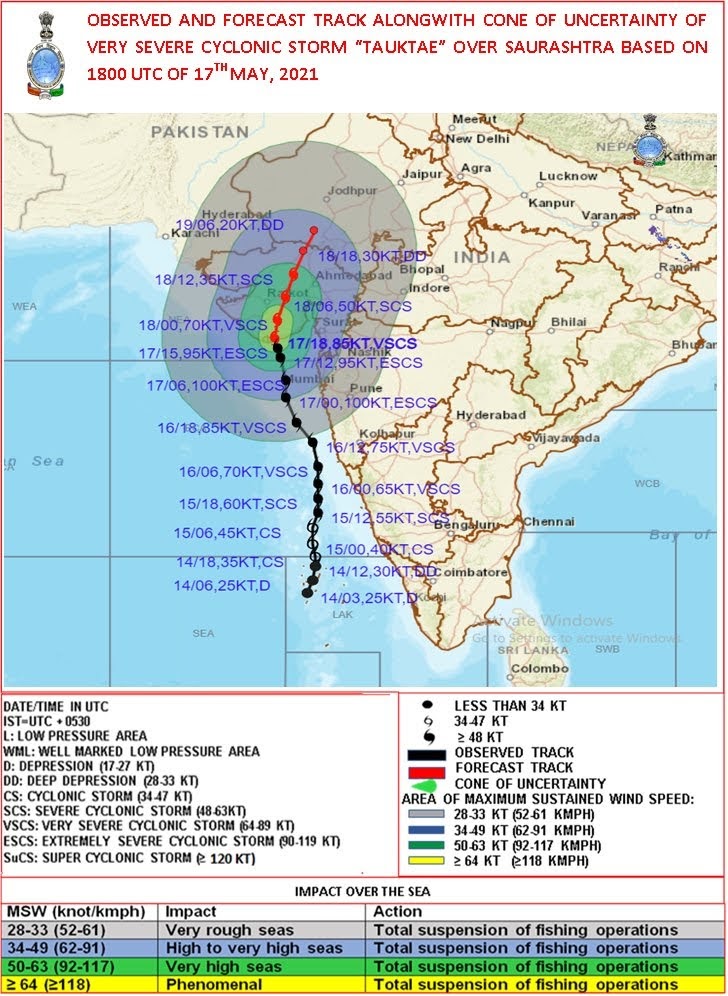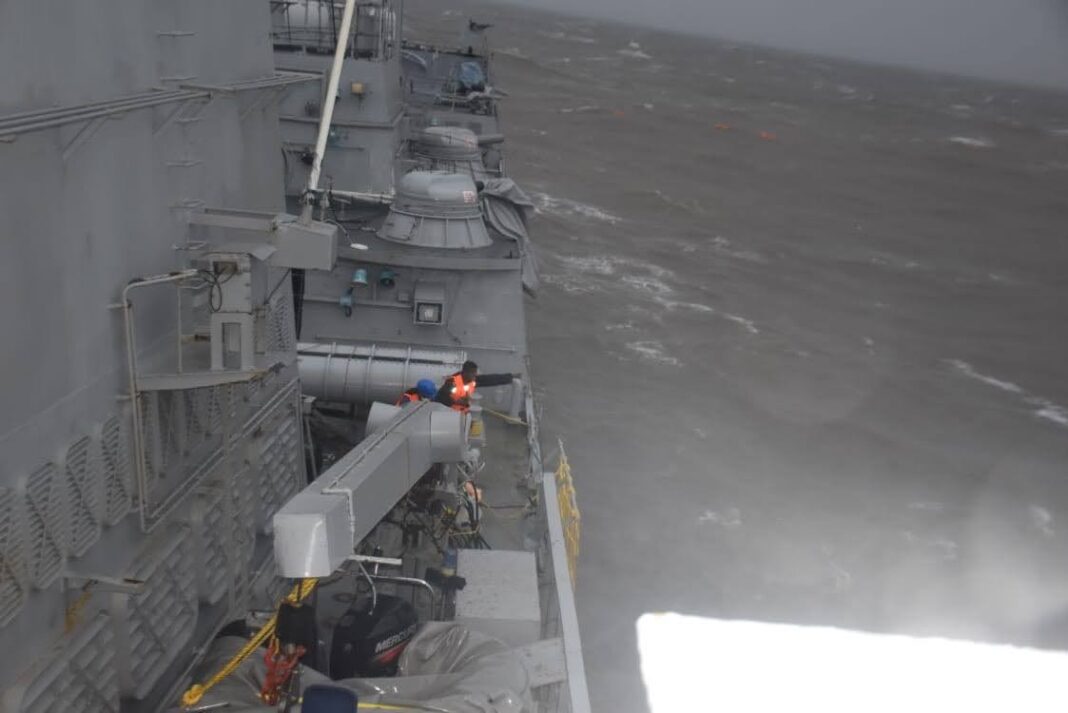‘What a day it was!’ is a phrase we have all used in our lives, often. Some days are awesome, adventurous, fun filled, romantic, whilst others are filled with adrenaline rush. Some days give new life and there are others that save lives. 17 May 2021, over a year ago, turned out to be a day made up of just everything. The crew of INS Kochi, ”Tough Tuskers” – as we proudly call ourselves, and the survivors of Barge Papaa 305 would, for years to come, reminisce on ‘What a Day it Was!’


Memories, scars in some cases, left by Cyclone Tauktae are still afresh in the minds of many, even after a year, and may probably fade with time. For me, however, like ‘some’, those memories would never fade. The ‘some’ in this case are the crew of Kochi, barge Papaa 305, MV Offshore Energy, MV Great Ship Ahilya and other Indian Naval ships in the area of the rescue operation. I, as a crew member sof INS Kochi, consider it an honour to have been part of those ‘some’. We witnessed a day wherein years of hard work, team effort and leadership traits were put to the stest. The crew of Kochi would go on to be a part of history by saving some 125 lives from the eye of a cyclone. A mission never attempted before and accomplished only by the divine grace of Lord Varuna, almost to perfection.

It was on the morning of 17 May 2021, when the ship was ordered to sail immediately into the Cyclone Tauktae. The preceding two days had been spent in giving out warnings, informing families and preparing for the incoming cyclone. The additional ropes were passed to the jetty, anchors lowered and all possible precautions were taken. Little did anyone imagine that the ship would be told to sail, instead.

Ships cast off in various weather conditions, extremely strong winds, heavy rains, near zeros visibility, strong tide, high swell, etc. But, 17 May 2021 was a day which had these factors at their extreme worst, and all together. Handling a ship in heavy weather is taught to and practiced by most of us. Avoiding heavy weather is what ships typically resort to. However on that fateful day, we were not to avoid the weather but to head right into it, to effect rescue operations. Sea state over 8/9, swell height of 35 feet, winds in excess of 55 knots (kn) (i.e 100 km/h), heavy rainfall, nil visibility, ship rolling about 30-35 degrees and ship drifting at 5 kn when stopped. I will leave the rest to imagination, if that still be the case.
Naval ships communicate with merchant vessels (MVs) for various reasons. However, to speak to someone who is onboard a sinking barge and being asked to expedite your arrival was a situation never expected. The barge kept asking for our time of arrival. This was not a simple question to answer. We assured them that we were proceeding at the best possible speed. Osbviously, our best speed was not enough. On reaching the area, sea state, swell and winds only worsened. The now frequent calls from the barge included permission to abandon ship, permission to lower life rafts, request for the ship to close them, etc. At about 1750 hrs, the crew abandoned the barge and we saw the barge sinking. A few minutes later we saw a group of survivors some 100 metres (m) to our port side. A large swell swept across and they were now 100 m on starboard side. We too were tossed 2-3 feet up in the air. Few seconds later, landing on my palms, I looked around and could not see one of my officers. My heart definitely skipped a beat or two. Everything about him flashed in front of my eyes in a fraction of a second. After a couple of seconds, I saw him stuck between the deck and helicopter safety nets with safety harness hooked on.

Though we could see the survivors a stone’s throw away, we soon realized that there was not much we could do. The ship was drifting at a rate of over 5 kn. Given the sea state, it was almost impossible for survivors to even grab a lifebuoy or swim towards the ship. We also realized that the helicopter deck was certainly not a place to rescue survivors. Scramble nets, otherwise considered an unpretentious seamanship gear saved the day, and lives, in the literal sense. As we rescued the first four survivors, hope and energy within the ship soared leading to excess volunteers in each rescue team, without nomination, throughout the next 40 hours of operation. There were four rescue teams of 10-15 personnel each, a Medical team and a team to look after the survivors.
A 163 m ship, displacing 8000 tonnes (T) had to be steered within a few feet of survivors in a sea state that was never even meant to be handled by the ship. During the first 7-8 hours, the survivors could climb scramble nets on their own, to safety. However, as time passed they were too tired to even hold on, let alone climb on their own. Innovating under exigent circumstances it was the Kochi’s crew who pulled up the scramble nets each time, with survivors clinging on to the net. In some cases, the survivors could not even hold on to the nets by themselves or were on the inner side of the nets, stuck between ship and net. The ship’s crew lowered themselves down onto the scramble nets and held on to the survivors. The entire net was then pulled up along with survivors and crew.

By 2215 hrs on 17 May 2021, we had rescued some 42 survivors and could not seemingly find any more. I must confess, I underestimated the ‘will to survive’ and almost thought that there may not be any more survivors. Never have I been more happy in my life to be proven wrong. At about 2315 hrs, as we glimpsed flickering lights from lifejackets worn by survivors, a new wave of energy, enthusiasm surged through our blood. All teams closed up to rescue more survivors. I remember, the next time I checked my watch it was 0542 hrs on 18 May 2021 and we had rescued 112 survivors by then. By the end of the day on 18 May, we had rescued 125.
This effort required frequent change of crew as it was strenuous. I had called for additional personnel at each post and there were several volunteers. However, what was heartening to see is that no one was ready to change positions or hand over to the next person despite being tired. Such was the commitment and enthusiasm of the men involved.
Management onboard, post recovery, was the next challenge. There was much to be done in terms of tending to the survivors than mere first-aid. No one on board swas specifically trained for the job. Hot water, sufficient fluids, warm and semi-solid food were near continuously administered. Given the sea state, working in galley was both challenging and risky, however, that did not deter the ship’s chefs from delivering the best, as always. Needless to say, the ships’ company provided their own personal clothing, mattresses, blankets, shoes and basic accessories to the survivors.

Apart from the survivors, Kochi also engaged in the recovery of the corpses of those who did not survive the fate of Papaa 305. The recovery was not easy, the bodies were swollen and difficult to hook on. The bodies were identified on the basis of documents found in the clohing, then kept in body bags and stored in a cool room, lest they decompose further.
Survivors had various stories to share. The fear of jumping from a barge, the kindling of hope after seeing the INS Kochi, the hopelessness when unable to climb the scramble nets, and the sigh of relief on being rescued to safety. There were survivors who attempted to ascend the scramble nets more than five times, whilst, others saw their colleagues drifting away from within inches from safety.
The fact that we had rescued 125 personnel from the eye of a cyclone did not really sink in till we interacted with the families of the survivors and members of the media. The survivors thanked the ship’s captain, the crew, the Navy and Lord Varuna for giving a second life. The ship and Navy received accolades from every corner, higher echelons, families, media and citizenry at large.
Whatever the outcome, I can however say that we proved to be Tough Tuskers, in the truest sense. I am proud that I was part of the team that delivered when called upon. What’s more satisfying is the fact that we came back without a single injury to men, machinery or equipment. Many in the Navy and the crew of Barge will go on to narrate this incident in the syears to come. Each one will have a different perspective; each one will recount his side of the story; each one will credit different aspects for the success of this mission; each one will have different heroes in the story. In the end, however, each one will say, WHAT A DAY IT WAS!!!
Note. This article is written by Commander Amit S Gore, who was the Second-in-Command of INS Kochi during the SAR undertaken in the aftermath of Cyclone Tauktae. A large number of the crew including the CO and the author were commended for bravery as part of the rescue operations. CO was awarded Shaurya Chakra. One officer was awarded NM (Gallantry). Five crew members including the author were commended by the Chief of the Naval Staff whilst seven crew members were commended by the C-in-C.
© Delhi Defence Review. Reproducing this content in full without permission is prohibited.
































